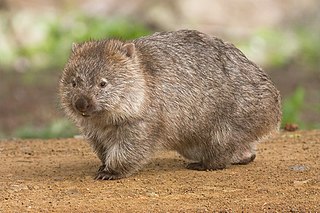
Wombats are short-legged, muscular quadrupedal marsupials that are native to Australia. They are about 1 m (40 in) in length with small, stubby tails and weigh between 20 and 35 kg. There are three extant species and they are all members of the family Vombatidae. They are adaptable and habitat tolerant, and are found in forested, mountainous, and heathland areas of southern and eastern Australia, including Tasmania, as well as an isolated patch of about 300 ha in Epping Forest National Park in central Queensland.
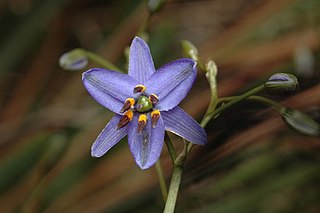
Dianella is a genus of about forty species of flowering plants in the monocot family Asphodelaceae and are commonly known as flax lilies. Plants in this genus are tufted herbs with more or less linear leaves and bisexual flowers with three sepals more or less similar to three petals and a superior ovary, the fruit a berry. They occur in Africa, South-east Asia, the Pacific Islands, New Zealand and Australia.

Prosotas dubiosa, the tailless lineblue or small purple lineblue, is a blue butterfly (Lycaenidae) found in Asia to Australia. The species was first described by Georg Semper in 1879.

Deudorix epijarbas, the cornelian or hairy line blue, is a species of lycaenid or blue butterfly found in south and southeast Asia from India to Fiji, including the Philippines, and also the tropical coast of Queensland in Australia. The species was first described by Frederic Moore in 1857.

The striated thornbill is a species of bird in the family Acanthizidae. It is endemic to Australia, where its natural habitat is subtropical or tropical dry forests.

Erysichton is a genus of butterflies in the family Lycaenidae. The species of this genus are found in the Australasian realm.

Prosotas is a genus of butterflies in the family Lycaenidae erected by Hamilton Herbert Druce in 1891. The species of this genus are found on New Guinea in the Australasian realm and the Indomalayan realm. An overview is provided by Hsu and Yen.

The green blotched moth is a moth of the family Noctuidae. It is found in New South Wales, Norfolk Island, Queensland, South Australia, Victoria, Western Australia and New Zealand.

Celtis paniculata is a coastal rainforest tree. In Australia it occurs from Kiama in New South Wales to the Endeavour River in tropical Queensland. It also grows at Norfolk Island, eastern Malesia, Micronesia, and Polynesia. In Australia it is commonly known as native celtis or investigator tree. Often seen in coastal areas, but may also be found up to 800 metres above sea level.
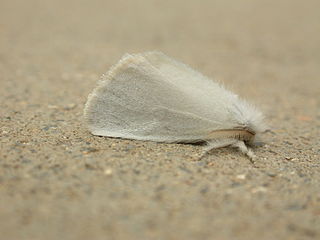
Acyphas semiochrea, the omnivorous tussock moth, is a moth of the subfamily Lymantriinae first described by Gottlieb August Wilhelm Herrich-Schäffer in 1855. It is found along most of the coast of Australia, including: New South Wales, Queensland, South Australia, Tasmania, Victoria and Western Australia.

Acacia lineataA.Cunn. ex G.Don, commonly known as streaked wattle or narrow lined-leaved wattle, occurs naturally inland eastern Australia. The genus Acacia is the largest genus of flowering plants in Australia, containing around 1000 species throughout a diverse range of environments from coast to desert.
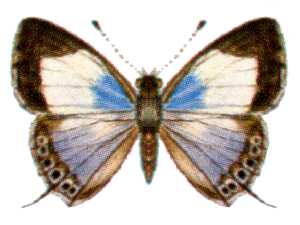
Jameela palmyra, the marbled blue, is a butterfly in the family Lycaenidae. It is found in along the coast of Australia, as well as in Indonesia, New Guinea and the Solomon Islands.
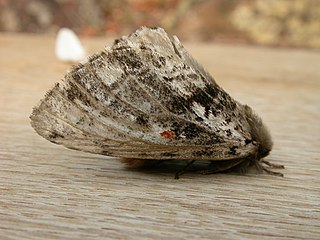
Aglaosoma variegata, the patterned notodontid, is a species of moth of the family Notodontidae first described by Francis Walker in 1855. It is known from the Australian states of New South Wales, Queensland and Victoria.

Dendrophthoe vitellina, commonly known as long-flowered- or apostle mistletoe, is a hemiparasitic plant of the mistletoe family Loranthaceae. The genus Dendrophthoe comprises about 31 species spread across tropical Africa, Asia, and Australia. Despite being collected by Joseph Banks and Daniel Solander in 1788, and depicted in Banks' Florilegium, it was not until 1860 that it was described by Ferdinand von Mueller as Loranthus vitellinus after being collected near Ipswich, and renamed by Philippe Édouard Léon Van Tieghem in 1895.
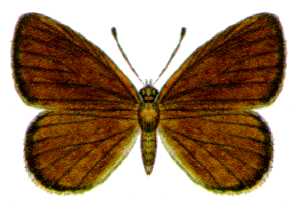
Candalides heathi, the rayed blue, is a species of butterfly of the family Lycaenidae. It is found in southern Australia, including South Australia, New South Wales and Victoria.

Persoonia hirsuta, commonly known as the hairy geebung or hairy persoonia, is a plant in the family Proteaceae and is endemic to eastern New South Wales. It is a hairy, spreading to low-lying shrub with linear, lance-shaped or spatula-shaped leaves and yellow or orange flowers arranged singly or in groups of up to ten on a rachis up to 20 mm (0.79 in) long.

Petrophile canescens, commonly known as conesticks, is a species of flowering plant in the family Proteaceae and is endemic to eastern Australia. It is an erect shrub with pinnately-divided leaves and oval heads of hairy, white to pale cream-coloured flowers.
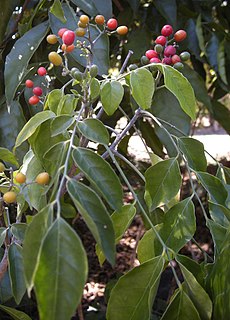
Micromelum minutum, commonly known as limeberry, dilminyin. kimiar margibur, tulibas tilos (Philippines), sesi (Indonesia) and samui (Thailand), is a species of small tree or shrub in the citrus plant family Rutaceae. It occurs from India and Indochina to Australia. It has pinnate leaves with egg-shaped to lance-shaped leaflets, hairy, pale green or creamish, scented flowers arranged in large groups and yellow to orange or red, oval to spherical berries in dense clusters.

Litsea australis, the brown bollygum or brown bollywood is a species of rainforest tree in the laurel family, found in eastern Australia. The specific epithet australis means "southern". As this southern population was considered to be Litsea leefeana, until reclassified by the rainforest botanist Bernie Hyland in 1989. This species is found in a variety of different rainforest types, but often seen growing near the sea. Distributed from Forster, New South Wales in the south to Fraser Island in Queensland.



















